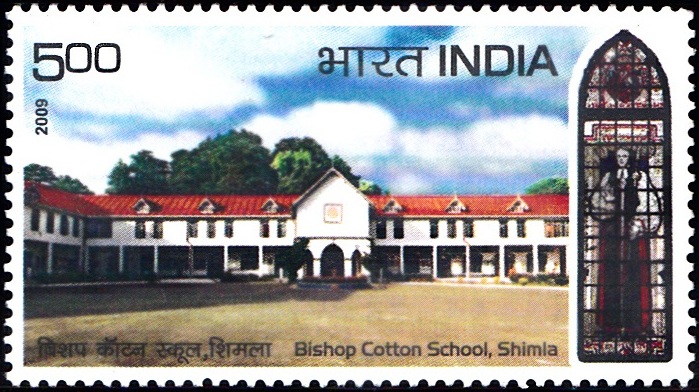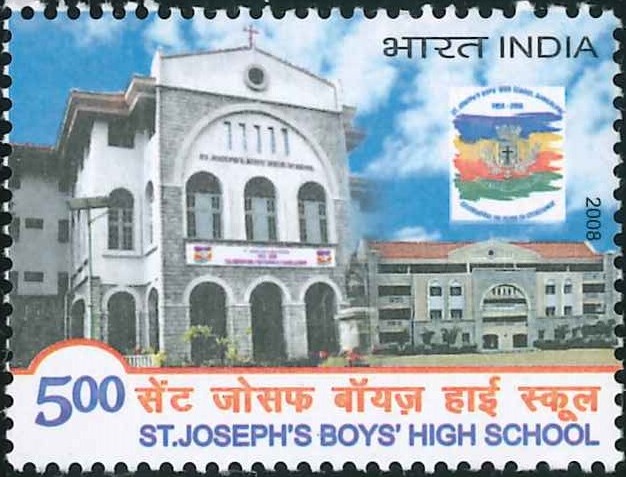
Bishop Cotton School, Shimla
A commemorative postage stamp on 150 years of Bishop Cotton School (Simla), one of the oldest boarding schools for boys in Asia :
 Issued by India
Issued by India
Issued on Oct 6, 2009
Issued for : The Department of Posts is happy to issue a commemorative postage stamp on Bishop Cotton School.
Credits :
Stamp design & FDC : Kamleshwar Singh
Cancellation : Alka Sharma
Type : Stamp, Mint Condition
Colour : Multi Colour
Denomination : 500 Paise
Stamps Printed : 0.4 Million
Printing Process : Wet–offset
Printer : Security Printing Press, Hyderabad
About :
- The word ‘Public School‘ is derived from the system of educating and preparing children for public service. They did not exist in India. The history of Bishop Cotton School is of interest for the part it played in the development of such public schools and in the wider history of education in this country. In the 1840’s there were no more than half a dozen such schools even in England and Eton, the largest, catered for fewer than 500 boys. In India there were a handful of private schools and military asylums, educating the children of their neighbourhood rather than the public at large. On the 28th July 1859 the Bishop of Calcutta held a service and collections were made in most of the Church of the Diocese for the raising of a Public School in some hill station in the Himalayas. The collections were utilized to found the school at Jutog on land and buildings given free by the Viceroy. Three private houses were purchased by Bishop Cotton out of the Indian Public School fund. The School opened on the 16th March 1863. Though mentioned in correspondence as the Simla Public School, it never actually bore this name. The first student, Frederic Taylor, joined the school on 18th March 1863, watched by the staff in curiosity and amusement and 35 boys were admitted that year and the school increased its strength to 65 students by the year end. Shifting to Knollswood spur, the foundation stone was laid on the 26th September 1866 by the then Viceroy, Sir John Lawrence, elder brother of Sir Henry Lawrence, founder of the Military Asylum at The Lawrence Royal Military School, Sanawar, now known as Lawrence School. In September 1868 the school moved to Knollswood. A fortnight after laying of the foundation stone, Bishop Cotton the founder drowned in an accident on 6th October 1866 while touring Assam. The name after the school was changed to Bishop Cotton School in 1867 in his memory.
- Bishop Cotton School, Shimla is the first public school in Asia to start the House system, organized games and the prefectorial system almost at the same time as it was developed in England. On Sunday, the 7th May 1905, the school caught fire and was completely burnt except the HM’s Lodge (1868), the hospital (1868), and the Senior Master’s House (1873). The school was rebuilt and occupied in July 1907. The school Chapel which was originally constructed on the 21st September 1871 was rebuilt and used from the 3rd April 1908. In 1926 a hostel was constructed for the Simla Hill Chiefs’ sons and relatives at a cost of Rs. 41,000/- financed entirely by the Hill Chiefs’. Later the hostel was expanded and nine more rooms were added and became the College section of the school, preparing the boys for the Intermediate Examination. In 1937 a Prep School was opened by buying the Ayrelif Girls School (now the Tibetan School in Chotta Shimla).
- The first Indian boy permitted to join the school was Suren Tagore in 1881 and Vishnu Singh followed in 1883. The four Indian School Captains were R.J. Gandhi in 1928, Harry Chukerbuti in 1936, Jehangzeb Khan in 1941 and Hasan Agha in 1946-47.
- A school is judged by its products. The school has produced ambassadors, UN contingent commanders, politicians, Members of Parliament in England and India, about a dozen Generals/Admirals/Air Marshals, leading industrialists, authors, a Chief Minister, Secretaries and an Air Chief.
- Text : Based on the material provided by the proponent.
Subscribe
Login
0 Comments







